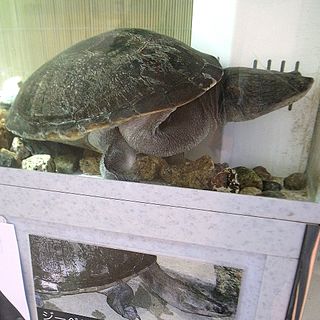
The giant Asian pond turtle inhabits rivers, streams, marshes, and rice paddies from estuarine lowlands to moderate altitudes throughout Cambodia and Vietnam and in parts of Laos, Malaysia, Myanmar and Thailand.

The Asian giant softshell turtle, also known commonly as Cantor's giant softshell turtle and the frog-faced softshell turtle, is a species of freshwater turtle in the family Trionychidae. The species is native to Southeast Asia. The species is critically endangered and in the 20th century has disappeared from much of its former range.

Macrochelys is a genus of very large freshwater turtles in the family Chelydridae, native to the Southeastern and Midwestern United States. Only a single extant species was recognized until 2014, when a study divided it into two or possibly three species. These turtles are easily recognized by three distinct dorsal ridges with raised spikes.

Chelus is a genus of large freshwater turtles found in tropical South America. Formerly considered to be a monotypic genus, it now consists of two extant species after Chelus orinocensis was identified in 2020 from a genetic analysis.

The black spine-neck swamp turtle, also commonly known as the spiny-neck turtle or Spix's sideneck turtle, is a species of turtle in the family Chelidae. The species is endemic to South America, specially in the Southern Cone region.

The painted terrapin, painted batagur, or saw-jawed turtle is a species of turtles in the family Geoemydidae. It was formerly in its own genus, Callagur, but has been reclassified to the genus, Batagur.

The New Guinea snake-necked turtle is a species of turtle in the family Chelidae. The species is found almost exclusively within Western Province, Papua New Guinea.
Pritchard's snake-necked turtle is a species of turtles in the family Chelidae. The species is endemic to a restricted area of Central Province, Papua New Guinea.
Reimann's snake-necked turtle is a species of turtle in the family Chelidae. The species is endemic to Oceania and Southeast Asia.
The Namoi River snapping turtle, also commonly known as Bell's turtle, the Namoi River elseya, or Bell's saw-shelled turtle, is a species of turtle in the family Chelidae. The species is endemic to New South Wales, Australia.

The Western New Guinea stream turtle or New Guinea snapping turtle is a species of freshwater turtle in the Chelidae family. It is found in the Bird's Head Peninsula and the Bomberai Peninsula west of Cenderawasih Bay, and on the island of Waigeo of West Papua, Indonesia.
The variable mud turtle, also known as Rhodesian mud turtle, Mashona hinged terrapin or variable hinged terrapin, is a species of turtle in the family Pelomedusidae. It is widely distributed in Central, East, and Southern Africa. The species was officially described by John Hewitt in 1927 and had to be broken into subspecies due to color variations on the heads of the turtles acrost the regions.

Sometimes called the bearded toadheads but better known by their scientific name of Phrynops this genus of turtles has often been a bit of a dumping ground for the short-necked South American turtles of the family Chelidae.

Mesoclemmys is a genus of South American turtles in the family Chelidae.
John L. Behler was an American naturalist, herpetologist, author, and activist known for his work in conserving endangered species of turtles, snakes, and other reptiles. He served as curator of herpetology at the Bronx Zoo, part of the Wildlife Conservation Society from 1976 to 2006. He co-chaired the IUCN Tortoise and Freshwater Turtle Specialist Group, and was a founding member of the Turtle Survival Alliance, which co-present the Behler Turtle Conservation Award with the Turtle Conservancy and Turtle Conservation Fund. The Behler Turtle Conservation Award is a major annual award to honor leadership in the field of freshwater turtle and tortoise conservation. The Turtle Conservancy named its captive breeding center, the Behler Chelonian Center, in his honor.

The Malayan snail-eating turtle is a species of turtle in Malayemys genus of the family Geoemydidae.

Elseya schultzei, commonly known as Schultze's snapping turtle, is a species of chelid turtle endemic to northern New Guinea.

Chelodina (Chelydera) kuchlingi, commonly known as Kuchling's long-necked turtle or Kuchling's turtle, is a species of freshwater turtle in the family Chelidae. The species is endemic to Australia.
Chelodina (Chelydera) walloyarrina, the Kimberley long neck turtle or Kimberley snake-necked turtle, is a large species of long neck turtle endemic to the Kimberley region of Western Australia. In recent years, it has been unclear as to whether this was a valid species or not. It has been recognised as such by the 2017 and 2021 editions of the Turtle Checklist. In a recent paper it waslisted as a subspecies of Chelodina burrungandjii by Kehlmaier et al. 2019, however, that publication did not actually assess the type of the species nore did it analyse it. Hence it should be considered a full species.
Chelus orinocensis, the Orinoco mata mata, is a species of freshwater turtle found in northern South America in the Orinoco, upper Rio Negro–Branco and Essequibo basins, and in Trinidad. It was split off from the very similar Chelus fimbriata in 2020.












